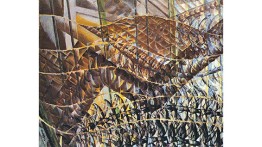Prof. Bedarida to Chair Italian Modernism Conference
POSTED ON: February 5, 2019

'Swifts: Paths of Movement + Dynamic Sequences' (1913) Giacomo Balla
Sixty years ago, in June, Twentieth-century Italian Art, the first exhibition of Italian modernism after the fall of Fascism, opened at the Museum of Modern Art. This February 12 Raffaele Bedarida, assistant professor of art history in the Faculty of Humanities and Social Sciences, will chair a free day-long conference at the Center for Italian Modern Art (CIMA) examining the lasting impact of the 1949 exhibition and the travelling exhibitions that resulted from it.
"Our interest is about the role of an art exhibition focusing on a former enemy, a country that the US Army was bombing just a couple of years before," Bedarida say. "How does a show impact collective memory? How does it modify historical accounts? How does it negotiate identities?"
The conference, formally titled Methodologies of Exchange: MoMA’s Twentieth—century Italian Art (1949), will be held at the Center for Italian Modern Art (CIMA), where Bedarida was once a fellow. The event is co-sponsored by the Terra Foundation for American Art and the Italian Art Society and presented as part of the annual College Art Association conference, “Methodologies of Exchange”
“Cultural diplomacy and artistic exchange between Italy and the US from Fascism to the Cold War is a topic I have been working on for many years,” Bedarida says. “Because art historians, in the last few years, have increasingly focused on transnational exchange and circulation of objects, I proposed this conference to CIMA and to the Terra Foundation as an opportunity to reflect on the possible methodologies for this type of study. In the conference we use one exhibition as a case study or an entry point through which we can address questions that otherwise would risk becoming abstract or vague. But I hope that the relevance of those questions goes beyond the specific field of Italy-US exchange.”
Bedarida will be staying busy this semester. Besides the conference he has also organized a lecture and concert in association with the Carnegie Hall series, “Migration: The Making of America.” Entitled, Magnifico in New York: Corrado Cagli, Migrating Artists, and the Mirage of Italy, the free event takes place on April 8 at 7 PM at the New York Public Library for the Performing Arts. Cagli, a Jewish, queer, Italian artist and cultural organizer was forced flee Italy under the fascists, relocating to New York. The event will focus on "The Triumph of Bacchus and Ariadne," a ballet conceived by Cagli in 1946 in collaboration with the choreographer George Balanchine. Cagli's story is the subject of Bedarida’s upcoming book, Corrado Cagli: Painting, Exile, America (Centro Primo Levi; 2020).




